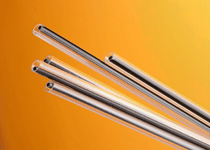Processor melds thermosets with thermoplastics in co-ex medical tubing development
Plastics processor PolyMedex Discovery Group has developed a means to co-extrude multilayer tubing that merges the best characteristics of thermoset polyimide with those of thermoplastic elastomers. For PolyMedex's customers, the primary value of the new tubing is the ability to utilize the benefits of thermoset polyimide, while mitigating its limitations.
November 10, 2010
Plastics processor PolyMedex Discovery Group has developed a means to co-extrude multilayer tubing that merges the best characteristics of thermoset polyimide with those of thermoplastic elastomers. For PolyMedex's customers, the primary value of the new tubing is the ability to utilize the benefits of thermoset polyimide, while mitigating its limitations.
|
New tubing option from PolyMeex combines polymide with TPE. |
PolyMedex (Putnam, CT) specializes in extrusions for use in minimally invasive medical devices and in drug delivery systems. For its latest trick, the company developed its own extrusion process to enable it to custom process multi-layer tubing of the two materials. The development, aimed at medical applications requiring a combination of high performance and manufacturability, brings together the high strength and tight tolerances of thermoset polyimide with material options and configurations available in TPEs.
Strength is a natural for thermoset polyimide; with a minimum tensile strength of 20,000 psi (138 MPa), it scores about 30% better than high-end engineering thermoplastics such as polyetheretherketone (PEEK). Polyimide tubing has a hard, glossy surface and is resistant to harsh chemicals. Its dielectric strength of 10,200 volts is comparable to that of glass. PolyMedex offers tubes extruded of the material with inner diameter (ID) tolerances of about 0.0051-0.013 mm, depending on diameter.
Stacked against those positive points are a few negative ones, principally that thermoset polyimide tubing is available in only in a round single lumen configuration and is difficult to bond, color or form thermally. In contrast TPEs can be extruded in almost unlimited configurations, including profiles and multilumen, and are available in a wide variety of durometers and stiffnesses. TPE tubing can also be thermally formed after extrusion to create critical catheter components such as traumatic tips and flares for connector fittings. PolyMedex hopes customers welcome the opportunity to have the best of both materials in a single product.
We had a question about the photo, because the tubes shown look less like co-extrusions than like one type of tube guided through another type. But Byron Flagg, the PolyMedex product manager, set us straight: "In this particular application, our customer wanted to achieve a 'tube within a tube' look for marketing reasons. So the polyimide element is darkly colored and is embedded within the clear thermoplastic outer by a very thin layer of material. This creates a pretty dramatic presentation of the two elements, but it is by no means the only possible configuration. More conventional tubing cross sections are also possible, where one or multiple polyimide elements are integrated into a thick walled multi-lumen extrusion. Such a design would result in a configuration similar to conventional coextruded lumen linings. There is tremendous flexibility in how the thermoset polyimide and thermoplastic polymer elements can be arranged to meet specific functional requirements."
About the Author(s)
You May Also Like



